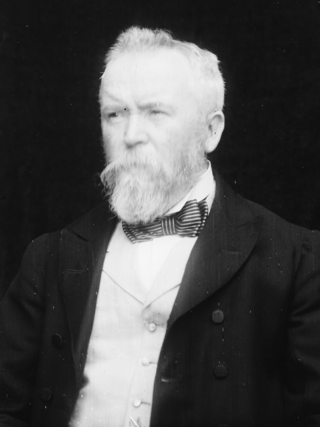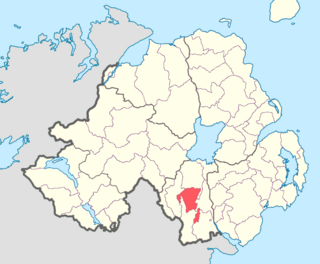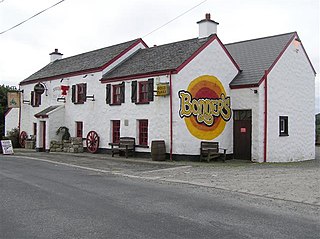
Jeremiah O'Donovan Rossa was an Irish Fenian leader who was one of the leading members of the Irish Republican Brotherhood (IRB). Born and raised in Rosscarbery, County Cork, he witnessed the Great Famine. Rossa founded the Phoenix National and Literary Society and dedicated his life to working towards the establishment of an independent Irish Republic. He joined the IRB, was arrested by the British and sentenced to life imprisonment. In 1869 he was elected to the British parliament while in prison. After being exiled to the United States in 1870 as part of the Cuba Five amnesty, Rossa worked with other Irish revolutionary organisations there to oppose British rule in Ireland.

Aghagallon (from Irish Achadh Gallan , meaning 'field of the standing stones' is a small village and civil parish in County Antrim, Northern Ireland. It is about four miles northwest of Moira, County Down, and had a population of 824 in the 2001 census.

Markethill is a village in County Armagh, Northern Ireland. It is beside Gosford Forest Park. It had a population of 1,647 people in the 2011 census.

Tullylish is a small village, townland and civil parish in County Down, Northern Ireland. It sits on the River Bann, along the main road between the towns of Banbridge and Portadown. In the 2001 census it had a population of 105 people. It lies within the civil parish of Tullylish and Banbridge District.

Loughgilly is a small village, townland and civil parish in County Armagh, Northern Ireland. It is on the main Armagh to Newry road, about halfway between the two. It is within the Armagh City and District Council area. It had a population of 84 people in the 2011 Census.

Larah or Laragh is a civil parish and townland in County Cavan, Ireland. The principal village in the civil parish is Stradone which is located 1 km from the N3 national road. Laragh is an ecclesiastical parish in the Roman Catholic Diocese of Kilmore. There are three churches in the parish namely in Larah, Clifferna and Carrickallen. There are two national schools, at Larah and Clifferna, respectively.

The Diocese of Armagh is the metropolitan diocese of the ecclesiastical province of Armagh, the Church of Ireland province that covers the northern half (approximately) of the island of Ireland. The diocese mainly covers counties Louth, Tyrone and Armagh, and parts of Down. The diocesan bishop is also the Archbishop of Armagh, the archbishop of the province, and the Primate of All Ireland. The Archbishop has his seat in St Patrick's Cathedral in the town of Armagh.

Mullaghbawn, or Mullaghbane, is a small village and townland near Slieve Gullion in County Armagh, Northern Ireland. In the 2011 Census it had a population of 596. At the 2021 Census this had risen to 642.

Kiltegan is a village in west County Wicklow, Ireland, on the R747 regional road close to the border with County Carlow. The village is in a townland and civil parish of the same name. The civil parish extends into County Carlow.

Danesfort is a civil parish, electoral division and rural townland in County Kilkenny, Ireland. Located approximately 6 km from Kilkenny City on the N10, the M9 motorway also passes through Danesfort townland.

Ballinora or Ballynora is a small rural parish and townland near Cork city and Ballincollig in County Cork, Ireland. The townland, which lies in the civil parish of Kilnaglory, is home to several education facilities and sporting clubs. The village of Waterfall is nearby.

Fews Lower is a barony in County Armagh, Northern Ireland. Its lies in the center of the county, with an enclave lying just to the south-east. The main portion is bordered by four other baronies: Armagh to the west; Oneilland West to the north; Orior Lower to the east; and Fews Upper to the south. Fews Upper and Orior Lower also border the enclave to its north and west, with Orior Upper to its south-west. The Fews Mountains run through both Fews Lower and Upper, the highest peak of which in Fews Lower is, Deadman's Hill, which stands at 1,178 ft. Fews Lower and Upper formed the barony of The Fews until it was sub-divided.

Mullaghduff is a townland in northwest County Donegal, Ireland. It forms part of the greater Rosses region and is officially in the Gaeltacht, however, English is the predominantly spoken language today.
Killallon civil parish is situated in the barony of Fore, County Meath. It has an area of 7,626 acres.

Saint Margaret's is a civil parish and townland in the historical barony of Coolock in County Dublin, Ireland. Rivermeade, a housing estate of 175 homes which is treated as a separate census town, is located between Saint Margaret's and the Ward River. Dublin Airport is also nearby.
Killeenagarriff is a civil parish in the historical barony of Clanwilliam in County Limerick, Ireland. Settlements in Killeenagarriff include the town of Annacotty, and population centres at Ahane and Barringtonsbridge.

Moyrourkan is a townland of 395 acres in County Armagh, Northern Ireland. It is situated in the civil parish of Mullaghbrack, in the historic barony of Orior Lower. It ranks as the 223rd largest townland in County Armagh.

















